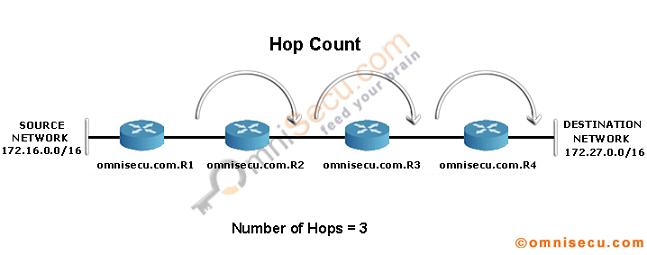RIP Metric Hope Count and Hop Count Calculation
RIP (Routing Information Protocol) uses hop count as its metric value.
Hop count is the number of routers (number of hops) from the source router through which data must pass to reach the destination network.

In above lab topology, omnisecu.com.R1 is the Source Network router and omnisecu.com.R4 is the Destination Network router. From Source Network Router, an IP datagram must hop three routers to reach the Destination Network, which are omnisecu.com.R2, omnisecu.com.R3, and omnisecu.com.R4.
Below show command "show ip route" output (from omnisecu.com.R1) shows the metric of RIP (Hop count) as 3.
omnisecu.com.R1#show ip route
Codes: C - connected, S - static, R - RIP, M - mobile, B - BGP
D - EIGRP, EX - EIGRP external, O - OSPF, IA - OSPF inter area
N1 - OSPF NSSA external type 1, N2 - OSPF NSSA external type 2
E1 - OSPF external type 1, E2 - OSPF external type 2
i - IS-IS, su - IS-IS summary, L1 - IS-IS level-1, L2 - IS-IS level-2
ia - IS-IS inter area, * - candidate default, U - per-user static route
o - ODR, P - periodic downloaded static route
Gateway of last resort is not set
C 172.16.0.0/16 is directly connected, Loopback0
R 172.27.0.0/16 [120/3] via 192.168.0.2, 00:00:06, Serial1/0
C 192.168.0.0/24 is directly connected, Serial1/0
R 192.168.1.0/24 [120/1] via 192.168.0.2, 00:00:06, Serial1/0
R 192.168.2.0/24 [120/2] via 192.168.0.2, 00:00:06, Serial1/0
From above output, [120/3] shows 120 is the default Administrative Distance of RIP (Routing Information Protocol) and 3 is the metric (Hop Count) of RIP (Routing Information Protocol) for above topology.
RIP (Routing Information Protocol) selects the best path to a Destination Network based only on the number of hops to the destination network. If you have multiple paths with different bandwidth to the destination network, then RIP’s best path calculation may become wrong.